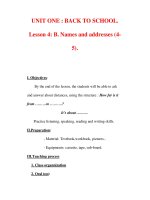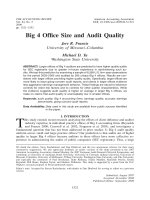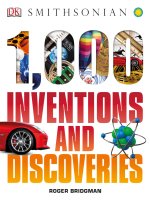4 14 inventions and change
Bạn đang xem bản rút gọn của tài liệu. Xem và tải ngay bản đầy đủ của tài liệu tại đây (2.41 MB, 10 trang )
Fascinating Facts
• An inventor working on radar got the idea for
the microwave oven after radio waves melted
a chocolate bar in his pocket.
• The modern zipper, invented in 1912, was
named for the sound it made when it was
used to close rubber boots.
• Clarence Birdseye, who invented a way
to freeze food for sale, got the idea from
watching the Inuits in Canada.
Genre
Nonfiction
Comprehension Skill
Summarize
Text Features
• Time Line
• Captions
Scott Foresman Social Studies
ISBN 0-328-14849-0
ì<(sk$m)=beiejd< +^-Ä-U-Ä-U
In this book you will read about the new
machines and new ways of doing things
that came about in the 1800s and 1900s.
During this time the daily lives of people
in the United States and around the world
changed forever.
Vocabulary
hydropower
invention
steamboat
Write to It!
Think of something you would like to
invent. What is it? How would it work? How
might it help people? Write a paragraph to
answer these questions.
Write your paragraph on a separate
sheet of paper.
Photographs
Every effort has been made to secure permission and provide appropriate credit for photographic material. The publisher deeply
regrets any omission and pledges to correct errors called to its attention in subsequent editions.
Unless otherwise acknowledged, all photographs are the property of Scott Foresman, a division of Pearson Education.
ISBN: 0-328-14849-0
Photo locators denoted as follows: Top (T), Center (C), Bottom (B), Left (L), Right (R) Background (Bkgd)
Copyright © Pearson Education, Inc.
All Rights Reserved. Printed in the United States of America. This publication is protected
by Copyright, and permission should be obtained from the publisher prior to any prohibited
reproduction, storage in a retrieval system, or transmission in any form by any means,
electronic, mechanical, photocopying, recording, or likewise. For information regarding
permission(s), write to: Permissions Department, Scott Foresman, 1900 East Lake Avenue,
Glenview, Illinois 60025.
Opener: ©The Granger Collection, NY
3 ©North Wind Picture Archives
Sales Offices: Needham, Massachusetts • Duluth, Georgia
4 ©Getty Images
Coppell, Texas • Sacramento, California • Mesa, Arizona
6 ©National Archives
9 ©Corbis
10 ©Bettman/Corbis
13 ©Mark Richards/PhotoEdit
14 ©Ewing Galloway/Camerique Inc., Int’l/Retrofile.com
15 ©Minnesota Historical Society/Corbis
1 2 3 4 5 6 7 8 9 10 V0G1 14 13 12 11 10 09 08 07 06 05
Editorial Offices: Glenview, Illinois • Parsippany, New Jersey • New York, New York
• Glenview, Illinois
A New Way to Work
Most families in the United States lived on farms until
the early 1800s. They made or grew most of the items
they needed. What they could not make they bought.
Around 1820 factories began to do much of the work
once done at home. Factories could make cloth and other
items quickly and cheaply because of new machines.
To buy goods people needed cash. Factories paid well.
Many people moved to towns and cities where they could
find factory work.
Cotton mills paid their workers two dollars a week.
At the time it was very good pay.
Some of the first factories were cotton mills. Mill
workers and machines turned raw cotton into cloth. Steam
engines powered some of the machines. Other factories
used hydropower. Swift moving water turned water
wheels, and the wheels turned the machines.
By 1836 more than twelve thousand young women
had moved to Lowell, Massachusetts. The young women
worked at the cotton mills thirteen hours a day, six days a
week.
2
3
Helping Farmers Grow More
In 1830 it took a farmer three hundred hours to grow
one hundred bushels of wheat. A farmer in 1987 could
grow that much with only three hours of work.
What made this possible? Inventions did. An invention
is a new machine or new way of doing something.
Inventors built machines that helped farmers get more
done with less work. Here are four examples of these
machines.
Farm Inventions, 1780–1900
1793
1750
1800
Automatic Milker
Leighton O. Colvin
invented the first
useful machine
for milking cows.
1850
1900
1834
1892
Mechanical Reaper
Cyrus Hall McCormick built a
machine to harvest wheat.
Tractor
A blacksmith in Iowa
put a gasoline engine
on iron wheels.
Tractors help farmers pull heavy equipment easily. They
can also cover a large field quickly.
4
1860
Cotton Gin
Eli Whitney
invented a
machine to pick
cottonseeds
from cotton.
5
Thomas Edison gave
this drawing of his light
bulb to the United States
Patent Office. The Patent
Office protects inventors
from people who might
try to steal their ideas.
About three thousand people came to his house in
Menlo Park, New Jersey. They looked at the lights and
thought about the future. Edison told them that such lights
would replace smelly and dangerous lanterns and gas
lamps.
In the late 1800s Edison supervised the building of
an electric power plant in New York City. Workers put
wires under the streets. The wires carried the electricity
into homes and offices. Factories could now stay open
all night.
Today it is hard to imagine living without electricity.
What would we do without radios and movies? They were
invented in the 1890s. What if we had no traffic lights?
They were invented in 1914.
Turning Night into Day
Thomas Edison did not invent the first light bulb.
However, he did invent a light bulb that lasted longer than
a candle. In 1879 Edison held a New Year’s Eve party.
He wanted to show off his invention.
6
7
America on the Move
In 1830 a New York inventor named Peter Cooper built
a steam locomotive called the Tom Thumb. By 1869 trains
were crossing the nation from New York to California.
The Tom Thumb was part of big changes in the way
Americans got around. The steamboat and the canal
boat helped move people and goods over water. New
roads helped link cities and towns over land.
The biggest change came with the automobile. In 1908
the Ford Model T car was cheap, sturdy, and easy to drive
and fix. Millions of people bought them.
Americans have been racing automobiles since 1895. The
races helped make people interested in owning cars.
Airplanes changed travel too. In 1903 Orville Wright
was the first person to fly an airplane powered by a
motor. The first flight lasted only twelve seconds.
These new ways to travel changed our economy. Trains
could carry crops hundreds of miles to markets, so farmers
grew more crops. Travelers needed places to sleep, so
motels were built. Cars led to new roads.
8
9
In 1876 Alexander Graham Bell invented the telephone.
The telephone also sent messages through wires. Now
people who were far apart could talk to each other
directly.
Then in 1894 an Italian inventor sent Morse code
signals, or messages using short and long sounds, over the
air. His name was Guglielmo Marconi. His invention made
radio possible. The world’s first radio station, KDKA in
Pittsburgh, Pennsylvania, began broadcasting in 1920 .
Trains were faster than horses. Telegrams were faster than
trains. Inventions like these made the world seem smaller.
Bringing Us Closer Together
From April 1860 to October 1861, some teenage
boys carried mail on horseback between Missouri and
California. Riding for the Pony Express paid well—one
hundred dollars a month. However, the job did not last
long. It was replaced by the telegraph, a new way of
sending messages through wires.
10
11
The Age of the Internet
From 1989 to 1991, Tim Berners-Lee created the World
Wide Web. The “Web” is a system that lets people share
the information they keep in their computers.
The Web and the Internet are not the same thing. The
Internet is a network, or connected system, of electronic
“highways.” The Web is like a chain of electronic trucks.
These trucks carry words, sound, and pictures over those
highways.
The Web caught on fast. Nearly a million people used the
Internet in 1991. Nearly six hundred million people used the
Internet in 2003.
You can use the World
Wide Web to find
information about almost
anything.
12
13
3. Refrigerators
The first refrigerators entered kitchens in the United
States in 1916. By 1920 refrigerators were in about
twenty thousand homes. By 1936 two million families
owned a refrigerator.
4. Improvements in Medical Care
People in the United States born in 1900 could expect
to live an average of forty-nine years. Those born in 2000
can expect to live an average of seventy-seven years.
Inventions in medical care made most of the difference.
Changes People Like Best
5. The Internet
In 1999 researchers asked Americans what inventions
they thought were the most important. Here are the top
five answers.
The Internet has put a world of information at our
fingertips.
1. Computers
The history of computers stretches back to an
Englishman named Charles Babbage (1791–1871).
In 1833 he drew plans for a machine to solve
math problems.
2. Television
Television had many parts that were invented
separately. One part was invented as far back as 1913.
By the 1950s televisions were very popular.
14
Twentieth-century
inventors made food
safer.
15
In this book you will read about the new
machines and new ways of doing things
that came about in the 1800s and 1900s.
During this time the daily lives of people
Glossary
in the United States and around the world
hydropower
power produced by capturing
changed forever.
the energy of flowing water
invention a new machine or new way
Vocabulary
of doing something
hydropower
steamboat a boat powered by a
steam engine invention
steamboat
Write to It!
Think of something you would like to
invent. What is it? How would it work? How
might it help people? Write a paragraph to
answer these questions.
Write your paragraph on a separate
sheet of paper.
Photographs
Every effort has been made to secure permission and provide appropriate credit for photographic material. The publisher deeply
regrets any omission and pledges to correct errors called to its attention in subsequent editions.
Unless otherwise acknowledged, all photographs are the property of Scott Foresman, a division of Pearson Education.
ISBN: 0-328-14849-0
Photo locators denoted as follows: Top (T), Center (C), Bottom (B), Left (L), Right (R) Background (Bkgd)
Copyright © Pearson Education, Inc.
All Rights Reserved. Printed in the United States of America. This publication is protected
by Copyright, and permission should be obtained from the publisher prior to any prohibited
reproduction, storage in a retrieval system, or transmission in any form by any means,
electronic, mechanical, photocopying, recording, or likewise. For information regarding
permission(s), write to: Permissions Department, Scott Foresman, 1900 East Lake Avenue,
16
Glenview, Illinois 60025.
Opener: ©The Granger Collection, NY
3 ©North Wind Picture Archives
4 ©Getty Images
6 ©National Archives
9 ©Corbis
10 ©Bettman/Corbis
13 ©Mark Richards/PhotoEdit
14 ©Ewing Galloway/Camerique Inc., Int’l/Retrofile.com
15 ©Minnesota Historical Society/Corbis
1 2 3 4 5 6 7 8 9 10 V0G1 14 13 12 11 10 09 08 07 06 05









